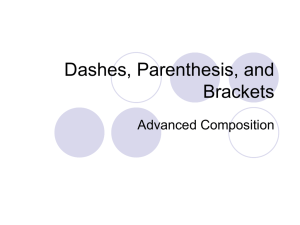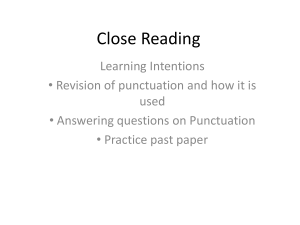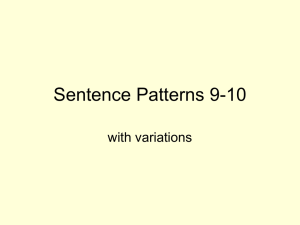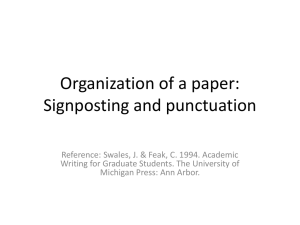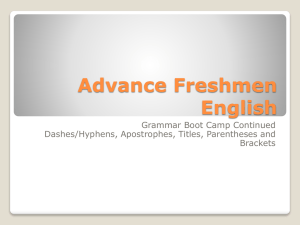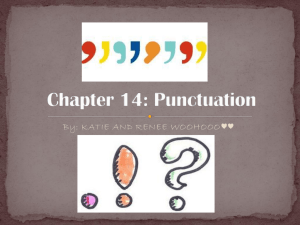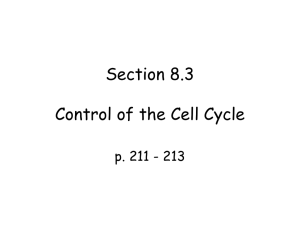Em dash
advertisement
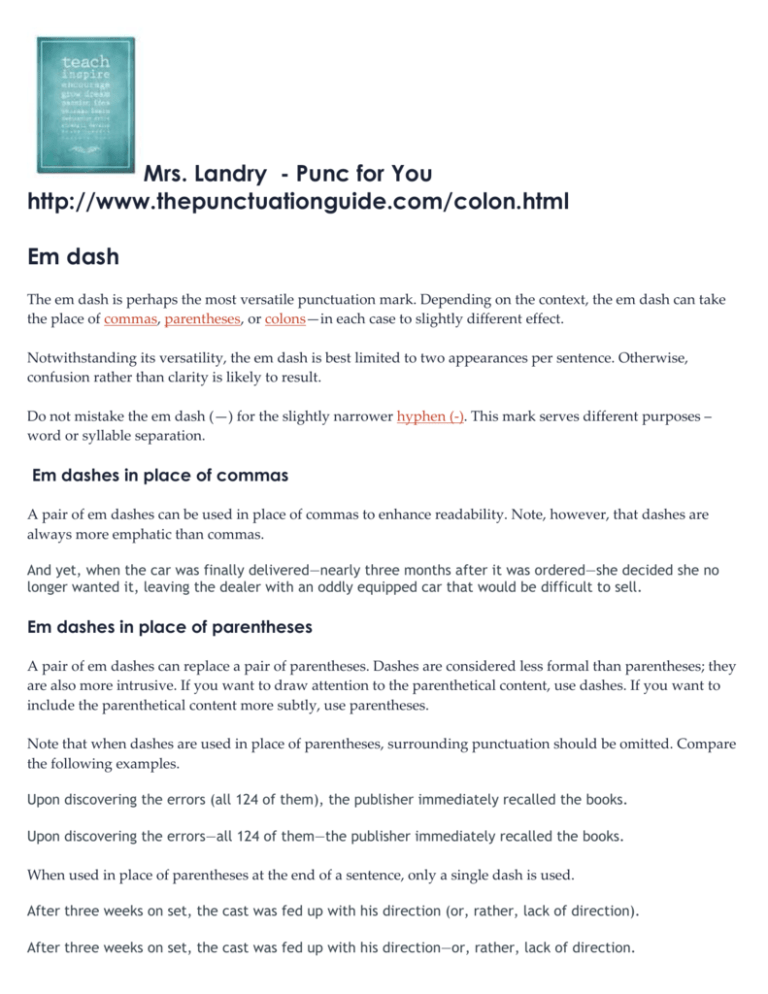
Mrs. Landry - Punc for You http://www.thepunctuationguide.com/colon.html Em dash The em dash is perhaps the most versatile punctuation mark. Depending on the context, the em dash can take the place of commas, parentheses, or colons—in each case to slightly different effect. Notwithstanding its versatility, the em dash is best limited to two appearances per sentence. Otherwise, confusion rather than clarity is likely to result. Do not mistake the em dash (—) for the slightly narrower hyphen (-). This mark serves different purposes – word or syllable separation. Em dashes in place of commas A pair of em dashes can be used in place of commas to enhance readability. Note, however, that dashes are always more emphatic than commas. And yet, when the car was finally delivered—nearly three months after it was ordered—she decided she no longer wanted it, leaving the dealer with an oddly equipped car that would be difficult to sell. Em dashes in place of parentheses A pair of em dashes can replace a pair of parentheses. Dashes are considered less formal than parentheses; they are also more intrusive. If you want to draw attention to the parenthetical content, use dashes. If you want to include the parenthetical content more subtly, use parentheses. Note that when dashes are used in place of parentheses, surrounding punctuation should be omitted. Compare the following examples. Upon discovering the errors (all 124 of them), the publisher immediately recalled the books. Upon discovering the errors—all 124 of them—the publisher immediately recalled the books. When used in place of parentheses at the end of a sentence, only a single dash is used. After three weeks on set, the cast was fed up with his direction (or, rather, lack of direction). After three weeks on set, the cast was fed up with his direction—or, rather, lack of direction. The em dash in place of a colon The em dash can be used in place of a colon when you want to emphasize the conclusion of your sentence. The dash is less formal than the colon. After months of deliberation, the jurors reached a unanimous verdict—guilty. The white sand, the warm water, the sparkling sun—this is what brought them to Hawaii. Multiple em dashes Two em dashes can be used to indicate missing portions of a word, whether unknown or intentionally omitted. Mr. J—— testified that the defendant yelled, “Die, a——,” before pulling the trigger. From the faded and water-damaged note, we made out only this: “Was ne——y going to m—— K——, but now ——t.” When an entire word is missing, either two or three em dashes can be used. Whichever length you choose, use it consistently throughout your document. Surrounding punctuation should be placed as usual. The juvenile defendant, ———, was arraigned yesterday. Spaces with the em dash The em dash is typically used without spaces on either side, and that is the style used in this guide. Most newspapers, however, set the em dash off with a single space on each side. Most newspapers — and all that follow AP style — insert a space before and after the em dash. Producing the em dash Many modern word processors will automatically insert an em dash when you type a pair of hyphens. Otherwise, look for an “insert symbol” command. If you are using a typewriter, a pair of hyphens is the closest you can get to an em dash. Semicolon The semicolon is sometimes described as stronger than a comma but weaker than a period. In certain uses, this is a reasonably accurate definition. Yet there is more to the semicolon than that. Between independent clauses when a coordinating conjunction is omitted Most commonly, the semicolon is used between two independent clauses (i.e., clauses that could stand alone as separate sentences) when a coordinating conjunction (for, and, nor, but, or,yet, so) is omitted. The upperclassmen are permitted off-campus lunch; the underclassmen must remain on campus. The example above could be recast with the conjunction but, in which case a comma, rather than a semicolon, would be required. The upperclassmen are permitted off-campus lunch, but the underclassmen must remain on campus. Technically, the semicolon could be replaced with a period, since each independent clause is a complete sentence. The semicolon, however, emphasizes the connection between the two clauses. Note: When the second clause expands on or explains the first, the colon is the better mark. Between independent clauses linked by a transitional expression The semicolon is also used between two independent clauses linked by a transitional expression (e.g., accordingly, consequently, for example, nevertheless, so, thus). Heavy snow continues to fall at the airport; consequently, all flights have been grounded. Hyperinflation makes it extremely difficult to keep track of prices; thus a quart of milk might cost $10 in the morning and $200 in the afternoon. In lists with internal commas The semicolon can also be used in lists with internal commas. In this usage, the semicolon acts as a sort of super-comma. The new store will have groceries on the lower level; luggage, housewares, and electronics on the ground floor; men’s and women’s clothing on the second floor; and books, music, and stationery on the third floor. In elliptical constructions When combined with a comma, the semicolon can be used in elliptical constructions. In this case, the comma serves as an ellipsis, eliminating the need to repeat an understood portion of the initial clause. In 1992, Starbucks had under 200 stores; ten years later, over 5,000. Some people brought food; others, clothing; yet others, merely a willingness to help. Colon The colon has primarily three grammatical uses and several non-grammatical uses. Introducing a list The colon is used to introduce a list of items. The bookstore specializes in three subjects: art, architecture, and graphic design. Do not, however, use a colon when the listed items are incorporated into the flow of the sentence. Correct: The bookstore specializes in art, architecture, and graphic design. Incorrect: The bookstore specializes in: art, architecture, and graphic design. Between independent clauses when the second explains or illustrates the first The colon is used to separate two independent clauses when the second explains or illustrates the first. In such usage, the colon functions in much the same way as the semicolon. As with the semicolon, do not capitalize the first word after the colon unless the word is ordinarily capitalized. I have very little time to learn the language: my new job starts in five weeks. A college degree is still worth something: a recent survey revealed that college graduates earned roughly 60% more than those with only a high school diploma. All three of their children are involved in the arts: Richard is a sculptor, Diane is a pianist, and Julie is a theatre director. When two or more sentences follow a colon, capitalize the first word following the colon. He made three points: First, the company was losing over a million dollars each month. Second, the stock price was lower than it had ever been. Third, no banks were willing to loan the company any more money. Emphasis The colon can be used to emphasize a phrase or single word at the end of a sentence. An em dash can be used for the same purpose. In the second example below, an em dash is more common than a colon, though the use of a colon is nevertheless correct. After three weeks of deliberation, the jury finally reached a verdict: guilty. Five continents, three dozen countries, over a hundred cities: this was the trip of a lifetime. Non-grammatical uses of the colon Time The colon is used to separate hours from minutes, with no space before or after the colon. 11:35 a.m. Ratio The colon is used to express a ratio of two numbers, with no space before or after the colon. 1:3 Biblical references The colon is used in biblical references to separate chapter from verse, with no space before or after the colon. Genesis 1:31 Other references The colon is used to separate the volume from page numbers of a cited work, with no space before or after the colon. Punctuation Quarterly 4:86–89 (read as “pages 86 through 89 of volume four”) Correspondence The colon is frequently used in business and personal correspondence. Dear Ms. Smith: cc: Tom Smith Attention: Accounts Payable PS: Don’t forget your swimsuit.
